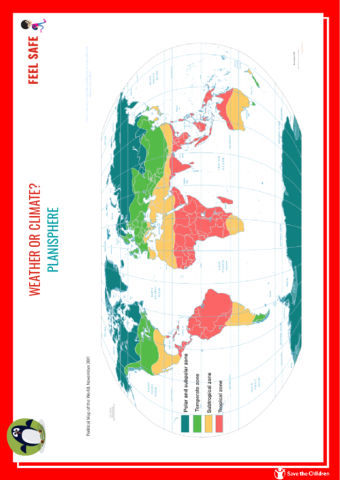Weather or Climate?
Objectives:
- Understand the main historical facts about climate
- Understand the difference between weather and climate
- Compare weather and climate data
Before starting
Climate and weather are often spoken of indistinctly in everyday language, but talking about climate or weather is not the same thing.
Weather (or meteorological weather) refers to the set of meteorological conditions (air temperature, pressure, humidity, wind direction and speed, etc.) that characterise the atmosphere at a given time and place.
When one thinks of climate, it refers to the knowledge of weather patterns in a specific place and season. In order to understand the climate of a particular region, it is necessary to analyse meteorological data collected over at least 30 years.
Climate also depends:
- On latitude, i.e. the distance of a place from the equator. Areas near the equator are hit by the sun's rays perpendicularly and are therefore very hot; areas near the poles receive the rays obliquely and are consequently very cold.
- Proximity to the sea and lakes makes the climate milder;
- From altitude, i.e. the height of a place in relation to sea level, as one rises the temperature decreases.
- From mountain ranges as they can obstruct the passage of cold winds and clouds;
- From the presence of woods and forests as they prevent the sun's rays from reaching the ground and warming it.
- From the presence of humans since in highly populated areas, pollution from industries and cars can cause the temperature to rise.
Meteorologists for a day!
After introducing and discussing the topic, the teacher divides the class into three groups.
Each group will be given three flashcards (see attachment "Weather or Climate? - Flashcards" below), depicting some of the world's capitals. With the support of the interactive whiteboard or a tablet, each group will have to fill in their flashcards with the required data. For the compilation, it is recommended that the students browse the "Accuweather" website (link).
At the end of the research, the teacher will collect the groups' research results, making sure to explain that what was researched only represents the weather condition of a city.
Guess the climate zone!
At this point, the teacher shows the class a planisphere. The class can either use a paper version that is already in the classroom, tracing the different climate zones of our Planet in pencil, or alternatively the class can use and print the "Planisphere" image (see attachment "Weather or Climate? - Planisphere" below).
The groups will have to take turns placing their capitals correctly inside the planisphere, putting their names on a piece of paper and guessing which climate zone each city belongs to.
The teacher explains that there are five major climate zones on Earth: one warm, two temperate and two cold. Within them there are different environments, some not very suitable for human life. At the poles, for example, there is ice and the temperature reaches more than 50 °C below zero, while in the hot deserts there is very little water available and very little vegetation. The Earth's population, therefore, is not distributed in the same way in the different areas of the Earth.
At that point, the teacher asks all groups to continue researching their capital cities by adding the following information:
- Average temperature in the four seasons of the year for the years 1970, 1980, 1990, 2010, 2020
- Average rainfall millimetres for the years 1970, 1980, 1990, 2010, 2020
Concluding thoughts
After finishing the research, the teacher invites the class to make final considerations from what they have learned. She may use some stimulus questions to guide the discussion:
- How much does the geographical location of a city in a given climate zone affect the weather?
- What considerations would you make when looking at the average temperatures and precipitation over the observed decades?


Add new comment